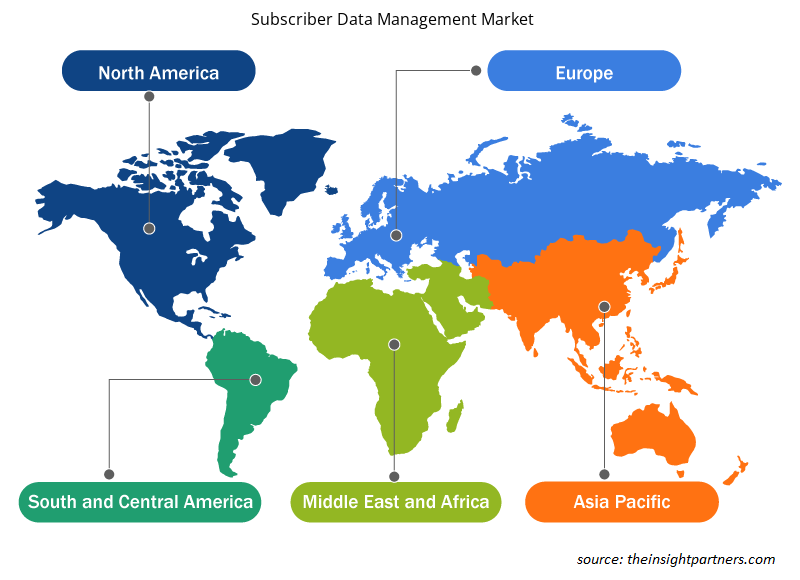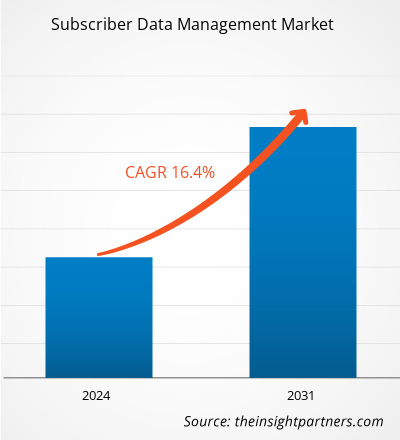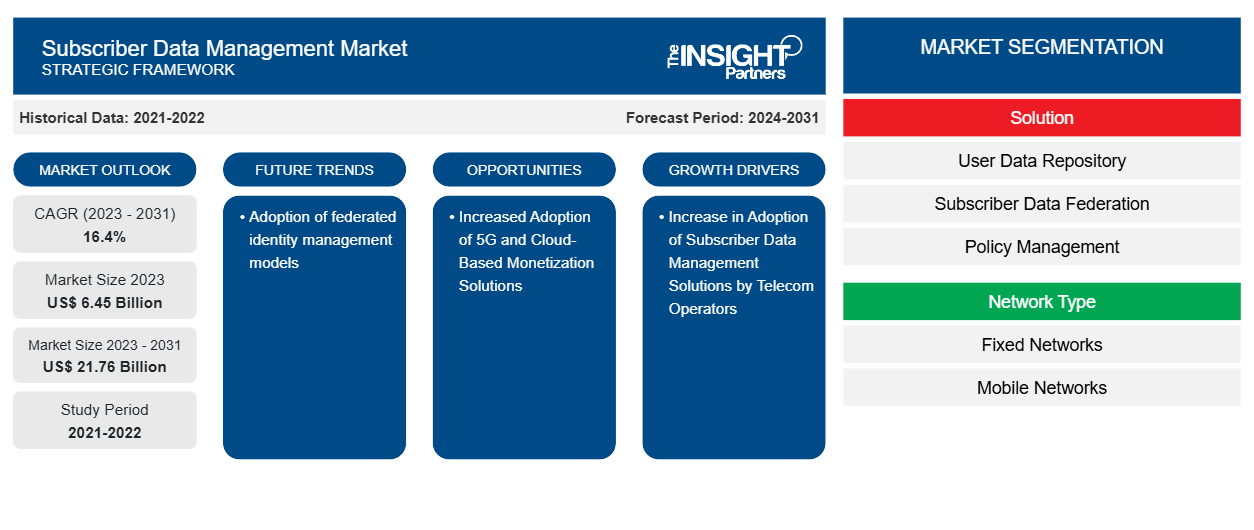Der Markt für Abonnentendatenmanagement soll von 6,45 Milliarden US-Dollar im Jahr 2023 auf 21,76 Milliarden US-Dollar im Jahr 2031 anwachsen. Für den Zeitraum 2023–2031 wird ein durchschnittliches jährliches Wachstum von 16,4 % erwartet. Die Einführung föderierter Identitätsmanagementmodelle dürfte ein wichtiger Trend auf dem Markt bleiben.
Abonnentendatenverwaltung Marktanalyse
Die steigende Anzahl mobiler Benutzer und Geräte sowie die Einführung von Network Function Virtualization (NFV) und IP-Systemen, gepaart mit der erhöhten Nachfrage der Teilnehmer nach LTE- und VoLTE-Technologien, treiben den Bedarf an Teilnehmerdatenverwaltung an.
Marktübersicht für Abonnentendatenverwaltung
Subscriber Data Management (SDM) bezeichnet die effiziente Verwaltung der Daten ihrer Verbraucher durch Telekommunikationsnetze an einem einzigen Standort. Die branchenübliche Praxis für das Datenmanagement bestand darin, separate Repositorien basierend auf dem Standort des Teilnehmers, dem Netzwerk (z. B. 2G/3G/5G) und anderen Faktoren zu verwenden. SDM ist eine sinnvolle Lösung, die alle Teilnehmerdaten für eine effizientere und sicherere Verwaltung der Benutzerdaten konsolidiert. Die SDM-Lösung vereinheitlicht und verwaltet die Teilnehmerdaten der Netzbetreiber, einschließlich Zugriffspräferenzen, Dienste, Standorte, Authentifizierung, Identitäten und Präsenz, in einheitlichen Datenrepositorien. Darüber hinaus verbessert sie die Netze der Betreiber, indem sie deren Betriebskosten senkt und gleichzeitig einen konsistenten Service für die Benutzer aufrechterhält. Außerdem können Betreiber Teilnehmerdaten zentral prüfen und so ihre Teilnehmerdaten effektiver monetarisieren. SDM unterstützt Telekommunikationsbetreiber auch dabei, die Netzwerkkomplexität, die Gesamtbetriebskosten und die Markteinführungszeit für neue Dienste zu senken.
Passen Sie diesen Bericht Ihren Anforderungen an
Sie erhalten kostenlos individuelle Anpassungen an jedem Bericht, einschließlich Teilen dieses Berichts oder einer Analyse auf Länderebene, eines Excel-Datenpakets sowie tolle Angebote und Rabatte für Start-ups und Universitäten.
-
Holen Sie sich die wichtigsten Markttrends aus diesem Bericht.Dieses KOSTENLOSE Beispiel umfasst eine Datenanalyse von Markttrends bis hin zu Schätzungen und Prognosen.
Markttreiber und Chancen für Abonnentendatenmanagement
Zunehmende Nutzung von Lösungen zur Teilnehmerdatenverwaltung durch Telekommunikationsbetreiber begünstigt den Markt
Die Subscriber Data Management (SDM)-Lösung konvergiert die Verwaltung von Abonnentendaten über verschiedene Netzwerkdomänen hinweg. Die SDM-Lösung vereinheitlicht und verwaltet die Abonnentendaten von Netzbetreibern, einschließlich Zugriffspräferenzen, Diensten, Standorten, Authentifizierung, Identitäten und Präsenz, in einheitlichen Datenspeichern. Darüber hinaus verbessert sie die Netze der Betreiber, indem sie deren Betriebskosten senkt und gleichzeitig den Benutzern einen konsistenten Service bietet. Außerdem können Betreiber Abonnentendaten zentral prüfen und so ihre Abonnentendaten effektiver monetarisieren. SDM unterstützt Telekommunikationsbetreiber auch dabei, die Netzwerkkomplexität, die Gesamtbetriebskosten und die Markteinführungszeit für neue Dienste zu senken.
Die Notwendigkeit, die Betriebskosten zu senken und die netzübergreifende Konvergenz zu erleichtern, sowie die steigende Nachfrage der Abonnenten nach LTE und VoLTE, die Implementierung von IMS und die Umstellung der Telekommunikationsunternehmen auf NFV-Technologien werden das Wachstum des Marktes für Abonnentendatenmanagement bei den Telekommunikationsunternehmen ankurbeln. Darüber hinaus können Drittparteien den Telekommunikationsanbietern dabei helfen, neue und verbesserte Dienste bereitzustellen, indem sie neue Wertschöpfungsketten bereitstellen, die langsam, aber sicher anerkannt werden. Telekommunikationsunternehmen prüfen die Möglichkeit, ihren Kunden ein ähnliches Maß an Personalisierung und Aktivitätsverfolgung bereitzustellen. Drittparteien könnten Abonnentendaten als besonders attraktiv empfinden, um die von ihnen bereitgestellten Dienste durch Nutzung der Infrastruktur der Telekommunikationsbetreiber zu verbessern. Die zunehmende Einführung von SDM-Lösungen durch Telekommunikationsbetreiber treibt das Marktwachstum somit erheblich an.
Verstärkte Nutzung von 5G und Cloud-basierten Monetarisierungslösungen
Die zunehmende Verbreitung der 5G-Technologie und cloudbasierter Monetarisierungslösungen treibt die Nachfrage nach Lösungen zur Verwaltung von Abonnentendaten an. Die 5G-Technologie ermöglicht es Telekommunikationsunternehmen, Verbraucherdaten in Echtzeit zu erfassen und fundierte Entscheidungen zu treffen. Durch die Implementierung eines analytikgesteuerten Kundenwertmanagements können Telekommunikationsunternehmen ihren Umsatz in nur vier Wochen um 5 bis 8 % steigern. Der Anstieg der cloudbasierten Verarbeitung und Speicherung sowie die Ausbreitung sozialer Medien und hochauflösender On-Demand-Videoinhalte treiben den Bedarf an Lösungen zur Verwaltung von Abonnentendaten an. Die Einführung von 5G und cloudbasierten Monetarisierungstechnologien schafft Potenzial für wichtige Branchenteilnehmer. Telekommunikationsunternehmen können Vereinbarungen mit Inhaltserstellern treffen, um 5G-fähige Erlebnisse zu monetarisieren, die eine kleinere Anzahl von Benutzern ansprechen. 5G bietet Betreibern zwei wichtige Geschäftsmöglichkeiten: Unterhaltung und Glücksspiel.
Segmentierungsanalyse des Marktberichts zur Abonnentendatenverwaltung
Wichtige Segmente, die zur Ableitung der Marktanalyse für Abonnentendatenverwaltung beigetragen haben, sind Lösung, Netzwerktyp, Bereitstellung und Anwendung.
- Basierend auf der Lösung ist der Markt nach Benutzerdaten-Repository, Abonnentendatenföderation, Richtlinienverwaltung und Identitätsverwaltung segmentiert. Das Segment Benutzerdaten-Repository hatte im Jahr 2023 einen bedeutenden Marktanteil.
- Basierend auf dem Netzwerktyp ist der Markt in Festnetze und Mobilfunknetze segmentiert. Das Segment Festnetze hatte im Jahr 2023 einen größeren Marktanteil.
- Basierend auf der Bereitstellung ist der Markt in Cloud und On-Premise segmentiert. Das Cloud-Segment hatte im Jahr 2023 den größten Marktanteil.
- Basierend auf der Anwendung ist der Markt in Voice-over-IP und Mobile segmentiert. Das Voice-over-IP-Segment hatte im Jahr 2023 den größten Marktanteil.
Marktanteilsanalyse für Abonnentendatenverwaltung nach Geografie
Der geografische Umfang des Marktberichts zur Abonnentendatenverwaltung ist hauptsächlich in fünf Regionen unterteilt: Nordamerika, Asien-Pazifik, Europa, Naher Osten und Afrika sowie Süd- und Mittelamerika.
Nordamerika dominierte den Markt im Jahr 2023. Laut dem Bericht der GSM Association wird es in Nordamerika bis 2022 100 Millionen 5G-Verbindungen geben, was auf die anhaltenden Netzwerkausgaben der Betreiber und eine wachsende Auswahl an 5G-Geräten in verschiedenen Preisklassen zurückzuführen ist. Nordamerika wird die erste Region sein, in der 5G bis 2025 mehr als die Hälfte aller Verbindungen ausmachen wird. Infolgedessen würde die steigende Zahl der 5G-Abonnenten die Netzbetreiber unter Druck setzen, der ordnungsgemäßen Verwaltung der Mobilfunktarife der Kunden Priorität einzuräumen, was zu einer erhöhten Nachfrage nach Abonnentendatenverwaltung führen würde. Der Ausbruch von COVID-19 und die anschließenden Lockdowns in Ländern wie den USA, Kanada und Mexiko haben die Zahl der OTT-Abonnenten in der gesamten Region deutlich erhöht. Laut der Studie von Comscore aus dem Jahr 2020 nutzten beispielsweise im April 2020 69,8 Millionen Haushalte in den USA OTT, ein Anstieg von 5,2 Millionen gegenüber dem Vorjahr.
Darüber hinaus sank das Musikstreaming im März 2020 drei Wochen in Folge, als die Pandemie in den USA erhebliche Auswirkungen zu haben begann. Zunächst um 2 %, dann um 8,8 % und schließlich um 3,2 %. In der Woche bis zum 2. April 2020 verzeichnete das Musikstreaming in den USA jedoch einen Anstieg um 2 %, und dieser Trend hält bis heute an. Somit hatte der Anstieg der Abonnentenzahlen auf verschiedenen Plattformen während der Pandemie einen positiven Einfluss auf den Markt für Abonnentendatenverwaltung in der gesamten Region.
Regionale Einblicke in den Markt für Abonnentendatenverwaltung
Die regionalen Trends und Faktoren, die den Markt für Abonnentendatenverwaltung im Prognosezeitraum beeinflussen, wurden von den Analysten von Insight Partners ausführlich erläutert. In diesem Abschnitt werden auch die Marktsegmente und die Geografie des Abonnentendatenverwaltungsmarktes in Nordamerika, Europa, im asiatisch-pazifischen Raum, im Nahen Osten und Afrika sowie in Süd- und Mittelamerika erörtert.

- Erhalten Sie regionale Daten zum Markt für Abonnentendatenverwaltung
Umfang des Marktberichts zur Abonnentendatenverwaltung
| Berichtsattribut | Details |
|---|---|
| Marktgröße im Jahr 2023 | 6,45 Milliarden US-Dollar |
| Marktgröße bis 2031 | 21,76 Milliarden US-Dollar |
| Globale CAGR (2023 - 2031) | 16,4 % |
| Historische Daten | 2021-2022 |
| Prognosezeitraum | 2024–2031 |
| Abgedeckte Segmente |
Nach Lösung
|
| Abgedeckte Regionen und Länder |
Nordamerika
|
| Marktführer und wichtige Unternehmensprofile |
|
Dichte der Marktteilnehmer im Bereich Abonnentendatenverwaltung: Die Auswirkungen auf die Geschäftsdynamik verstehen
Der Markt für Abonnentendatenverwaltung wächst rasant, angetrieben durch die steigende Nachfrage der Endnutzer aufgrund von Faktoren wie sich entwickelnden Verbraucherpräferenzen, technologischen Fortschritten und einem größeren Bewusstsein für die Vorteile des Produkts. Mit steigender Nachfrage erweitern Unternehmen ihr Angebot, entwickeln Innovationen, um die Bedürfnisse der Verbraucher zu erfüllen, und nutzen neue Trends, was das Marktwachstum weiter ankurbelt.
Die Marktteilnehmerdichte bezieht sich auf die Verteilung der Firmen oder Unternehmen, die in einem bestimmten Markt oder einer bestimmten Branche tätig sind. Sie gibt an, wie viele Wettbewerber (Marktteilnehmer) in einem bestimmten Marktraum im Verhältnis zu seiner Größe oder seinem gesamten Marktwert präsent sind.
Die wichtigsten Unternehmen auf dem Markt für Abonnentendatenverwaltung sind:
- Cisco Systems, Inc.
- Hewlett Packard Enterprise Development LP
- Huawei Technologies Co., Ltd.
- Nokia Corporation
- Oracle Corporation
- Telefonaktiebolaget LM Ericsson
Haftungsausschluss : Die oben aufgeführten Unternehmen sind nicht in einer bestimmten Reihenfolge aufgeführt.

- Überblick über die wichtigsten Akteure auf dem Markt für Abonnentendatenverwaltung
Marktnachrichten und aktuelle Entwicklungen zum Abonnentendatenmanagement
Der Markt für Abonnentendatenmanagement wird durch die Erhebung qualitativer und quantitativer Daten nach Primär- und Sekundärforschung bewertet, die wichtige Unternehmensveröffentlichungen, Verbandsdaten und Datenbanken umfasst. Nachfolgend sind einige der Entwicklungen auf dem Markt für Abonnentendatenmanagement aufgeführt:
- Cisco gab den Abschluss der Übernahme von Socio Labs, Inc. bekannt. Damit will das Unternehmen das WebEx-Angebot über Meetings, Webinare und Webcasts hinaus auf Konferenzen ausweiten und die Zukunft hybrider Veranstaltungen vorantreiben. Socio Labs ist eine moderne Event-Technologieplattform, die den gesamten Lebenszyklus von virtuellen, persönlichen und hybriden Konferenzen mit mehreren Sitzungen und mehreren Spuren verwaltet. (Quelle: Cisco, Pressemitteilung, Juli 2021)
- Cisco hat sich mit Vodafone Idea Limited zusammengetan, um das Netzwerk zu vereinfachen und zu automatisieren, damit 4G- und 5G-Anwendungsfälle unterstützt werden. Außerdem bietet es seinen Privat-, Einzelhandels- und Unternehmenskunden ein qualitativ besseres Erlebnis. Zu diesem Zweck setzt Vodafone Idea Ciscos Ultra Packet Core in ganz Indien ein, um die digitale Transformation zu beschleunigen. (Quelle: Cisco, Pressemitteilung, Juni 2021)
Marktbericht zum Abonnentendatenmanagement – Abdeckung und Ergebnisse
Der Bericht „Marktgröße und Prognose für Abonnentendatenverwaltung (2021–2031)“ bietet eine detaillierte Analyse des Marktes, die die folgenden Bereiche abdeckt:
- Marktgröße und Prognose für Abonnentendatenverwaltung auf globaler, regionaler und Länderebene für alle wichtigen Marktsegmente, die im Rahmen des Berichts abgedeckt sind
- Markttrends und Marktdynamiken im Bereich Subscriber Data Management wie Treiber, Einschränkungen und wichtige Chancen
- Detaillierte PEST/Porters Five Forces- und SWOT-Analyse
- Marktanalyse für Abonnentendatenverwaltung mit wichtigen Markttrends, globalen und regionalen Rahmenbedingungen, wichtigen Akteuren, Vorschriften und aktuellen Marktentwicklungen
- Branchenlandschaft und Wettbewerbsanalyse, die die Marktkonzentration, Heatmap-Analyse, prominente Akteure und aktuelle Entwicklungen für den Markt für Abonnentendatenverwaltung umfasst
- Detaillierte Firmenprofile
- Historische Analyse (2 Jahre), Basisjahr, Prognose (7 Jahre) mit CAGR
- PEST- und SWOT-Analyse
- Marktgröße Wert/Volumen – Global, Regional, Land
- Branchen- und Wettbewerbslandschaft
- Excel-Datensatz
Aktuelle Berichte
Verwandte Berichte
Erfahrungsberichte
Grund zum Kauf
- Fundierte Entscheidungsfindung
- Marktdynamik verstehen
- Wettbewerbsanalyse
- Kundeneinblicke
- Marktprognosen
- Risikominimierung
- Strategische Planung
- Investitionsbegründung
- Identifizierung neuer Märkte
- Verbesserung von Marketingstrategien
- Steigerung der Betriebseffizienz
- Anpassung an regulatorische Trends























 Kostenlose Probe anfordern für - Markt für Abonnentendatenverwaltung
Kostenlose Probe anfordern für - Markt für Abonnentendatenverwaltung